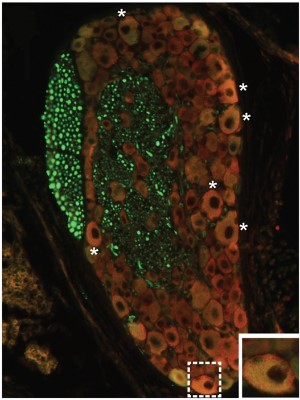Overview
- Peptide (C)ELVPSARAELQSSPLVN corresponding to amino acid residues 2-18 of mouse δ-Opioid receptor (Accession P32300). Extracellular, N-terminus.
- Rat cortex lysate (1:200).
 Western blot analysis of a rat cortex lysate:1. Anti-δ-Opioid Receptor (OPRD1) (extracellular) Antibody (#AOR-014), (1:200).
Western blot analysis of a rat cortex lysate:1. Anti-δ-Opioid Receptor (OPRD1) (extracellular) Antibody (#AOR-014), (1:200).
2. Anti-δ-Opioid Receptor (OPRD1) (extracellular) Antibody, preincubated with δ-Opioid Receptor/OPRD1 (extracellular) Blocking Peptide (#BLP-OR014).
- Rat spinal cord frozen section (1:100).
- Rat neonatal drenomedullary chromaffin cells (AMCs) (Salman, S. et al. (2013) J. Physiol. 591, 515.).
Endogenous opiates such as endorphins, endomorphins, and enkephalins, as well as opiate drugs (including morphine) exert their effects by binding to opioid receptors. Three "classic" types of opioid receptors have been identified: mu (µ)-opioid (MOP) receptor, delta (δ)-opioid (DOP) receptor, and kappa (κ)-opioid (KOP) receptor.1 Recently, the nociceptin/orphanin FQ (N/OFQ) peptide (NOP) receptor was also described. Despite its significant sequence homology, its pharmacological profile differs greatly from those of the classic µ, δ, and κ receptors.2
The opioid receptors belong to the G protein-coupled receptor (GPCR) superfamily whose members share a common structure of seven putative transmembrane domains, an extracellular amino terminus, a cytoplasmic carboxyl terminus, and a third intracellular loop important for binding G proteins.1
All three classic opioid receptors mediate opioid-induced analgesia. Supraspinal analgesia is mainly mediated by the µ-opioid receptor, whereas µ-, δ-, and κ-receptors participate in the control of pain at the spinal level.3 The opioid receptors also mediate the mood-altering properties of opioids.4 Cross-talk between µ- and δ- opioid receptors was demonstrated when subeffective doses of d-opioid receptors agonists modulated m-mediated analgesia.5
The δ receptors are discretely distributed in the central nervous system (CNS), with a prominent gradient of receptor density from high levels in forebrain structures to relatively low levels in most hindbrain regions.2
Application key:
Species reactivity key:

Expression of DOR-1 in mouse DRGs.Immunohistochemical staining of mouse DRG sections using Anti-δ-Opioid Receptor (OPRD1) (extracellular) Antibody (#AOR-014). DOR-1 expression (red) is expressed in DRGs and co-localizes with NF200 (green). Adapted from Reed-Geaghan, E.G. et al. (2016) J. Neurosci. 36, 4362. with permission of the Society for Neuroscience.
